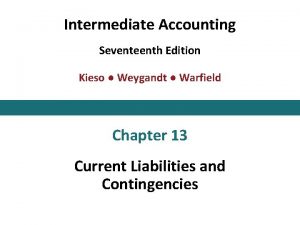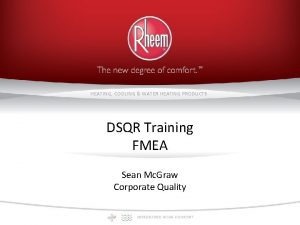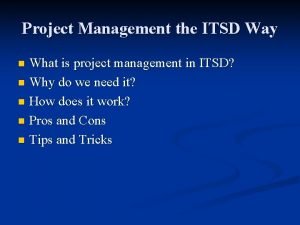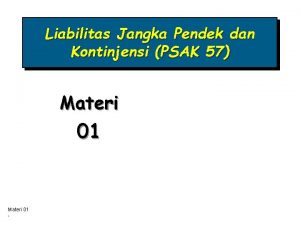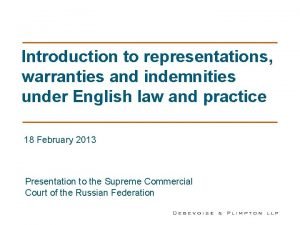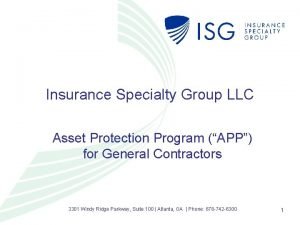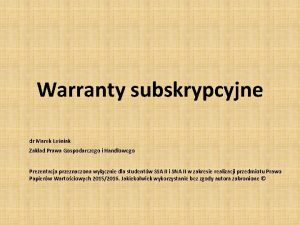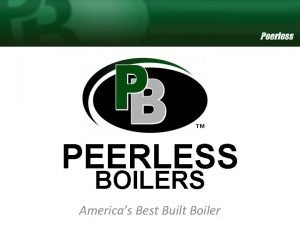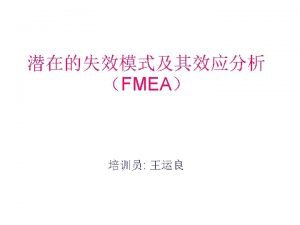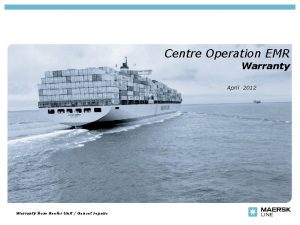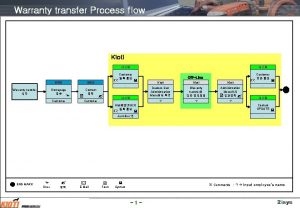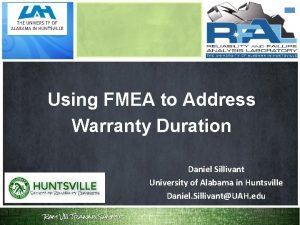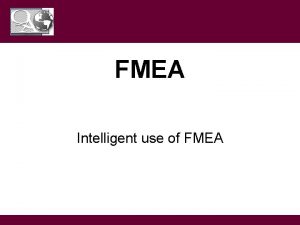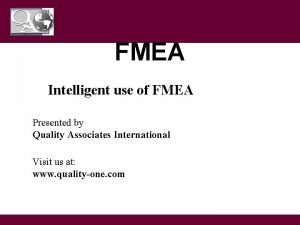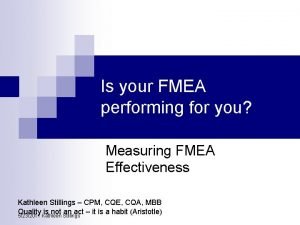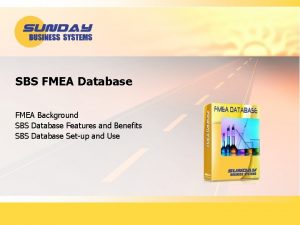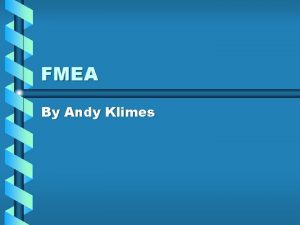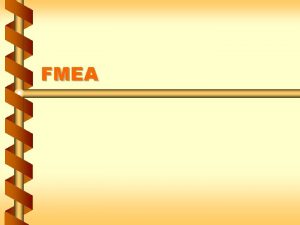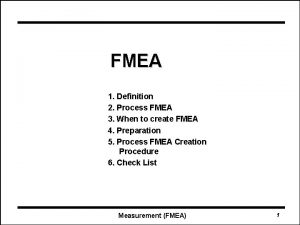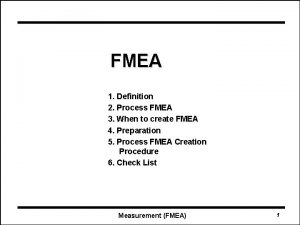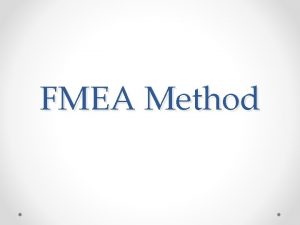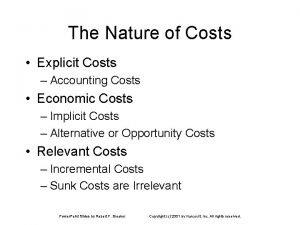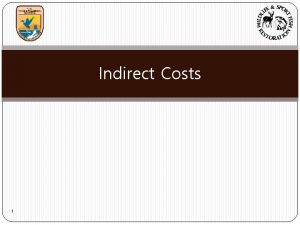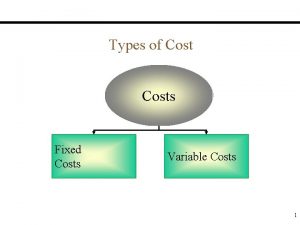FMEA Training Purpose of the FMEA Warranty costs

























- Slides: 25

FMEA Training

Purpose of the FMEA Warranty costs Detection and correction of defects Detection and correction EXTERNAL defects D-FMEA P-FMEA Identify and eliminate potential defects Cost of validation Validation tests Preventive costs Product development Project planning Preproduction Production Manufacturer / supplier Lifetime Customer Preventive costs to identify potential defects by FMEA’s are relatively low compared to in-house detection and correction of defects and even much lower than recovery costs in case defects are found by our Customers. Page 2

FMEA Purpose of the FMEA: • Methodology that facilitates process improvement • Identifies and eliminates concerns early in the development of a process or design • Improve internal and external customer satisfaction • Risk Management tool, focuses on prevention • FMEA may be a customer requirement (likely contractual, Level 3 PPAP, ISO 9001) 3 Page 3

Learning FMEA, Training Objectives: • To understand the use of Failure Modes and Effect Analysis(FMEA) • To learn the steps to developing FMEAs • To summarize the different types of FMEAs • To learn how to link the FMEA to other Process tools 4 Page 4

FMEA, Summary FMEA, a mathematical way to identify: • failure modes, the ways in which a product or process can fail • the Effects and Severity of a failure mode • Potential causes of the failure mode • the Occurrence of a failure mode • the Detection of a failure mode • the level of risk (Risk Priority Number) • actions that should be taken to reduce the RPN = Severity X Occurrence X Detection 5 Page 5

Benefits FMEA, Inputs might include other tools such as: D-FMEA (Part and Assembly level) Defines VOC • • Customer requirements CTQ Flow down analysis Quality Function Deployment (House Of Quality) Risk assessments P-FMEA (Process level) Delivers VOC • • Process flowchart Sequence Of Events Process Tooling Poka-Yoke list 6 Page 6

FMEA, Application Examples There are several situations where an FMEA is the optimal tool to identify risk: • Process-FMEA: • Introducing a new process • Reviewing existing processes after modifications • Introduce new Part Numbers on an existing Production Line • Design-FMEA: • Introducing a new Design, Part, Sub Assembly or Assembly • Use an existing Design for another application • Reviewing existing Designs after modifications 7 Page 7

What Is A Failure Mode? A Failure Mode is: • The way in which the component, subassembly, product or process could fail to perform its intended function • Failure modes may be the result of previous operations or may cause next operations to fail • Things that could go wrong INTERNALLY: • Warehouse • Production Process • Things that could go wrong EXTERNALLY: • Supplier Location • Final Customer 8 Page 8

When to Conduct an FMEA? • Early in the New Product Introduction (A-Build) complete for B build. • When new systems, products, and processes are being designed • When existing designs or processes are being changed, FMEA’s to be updated • When process improvements are made due to Corrective Action Requests 9 Page 9

History of FMEA: • First used in the 1960’s in the Aerospace industry during the Apollo missions • In 1974, the Navy developed MIL-STD-1629 regarding the use of FMEA • In the late 1970’s, the automotive industry was driven by liability costs to use FMEA • Later, the automotive industry saw the advantages of using this tool to reduce risks related to poor quality (QS-9000, VDA and ISO-TS 16949 standard) Page 10 1 0

History of FMEA, Case Study, what could have been avoided using FMEA Aubie. Sat-1 was the first ever, 4 -inch Cube Satellite to be accepted by NASA for launch. It was launched into space 28 th October 2011 from Vandenberg Air Force Base in California on a NASAsponsored Delta II rocket. Page 11 1 1

History of FMEA, Case Study What was the failure mode? Once the satellite was deployed: • the team had problems making contact with the satellite • One of the 2 antennae failed to deploy • The signal transmitter at the control center did not have enough power to communicate with the satellite How was it solved? Lessons learned: • Plan for errors! The use of an FMEA most likely had avoided the malfunction involving people from the earlier flight • Teamwork! The collaboration relationship between teams enabled the team to use the alternative equipment. Without it, the mission could have failed. • The team used another signal transmitter from an earlier flight which had enough power to enable communication Why Do I Care? First Time Right, Calculated Risk, Rights Team will safe resources! Page 12 1 2

Types of FMEAs Design FMEA • Analyzes product design before release to production, with a focus on product function • Analyzes systems and subsystems in early concept and design stages Process FMEA • Used to analyze manufacturing and assembly processes before they are implemented Page 13 1 3

FMEA: A Team Tool • A team approach is necessary, see example Aubie. Sat-1 communication problems could have been avoided by involving a practical experienced team! • Team should be led by the Right person, Design, Manufacturing or Quality Engineer, etc…familiar with FMEA • The following Team members should be considered: Ø Ø Ø Ø Design Engineers Process Engineers Supply Chain Engineers Line Design Engineers Suppliers Operators Practical Experts Page 14 1 4

The FMEA Form Identify failure modes and their effects Page 15 Identify causes of the failure modes and controls Prioritize Determine and assess actions 1 5

FMEA Procedure 1. For each process input determine the ways in which the input can go wrong (failure mode) 2. For each failure mode, determine effects Select a Severity level for each effect 3. Identify potential causes of each failure mode Select an Occurrence level for each cause 4. List current controls for each cause Select a Detection level for each cause RPN = Severity X Occurrence X Detection Page 16 1 6

FMEA Procedure (Cont. ) 5. Calculate the Risk Priority Number (RPN) 6. Develop recommended actions, assign responsible persons, and take actions • Give priority to high RPNs • MUST look at highest severity 7. Assign the predicted Severity, Occurrence, and Detection levels and compare RPNs (before and after risk reduction) Page 17 1 7

Rating Scales • Preferred Scales are 1 -10 • Adjust Occurence scales to reality figures for your company Severity: 1 = Not Severe, 10 = Very Severe Occurrence: 1 = Not Likely, 10 = Very Likely Detection: 1 = Easy to Detect, 10 = Not easy to Detect Page 18 1 8

The FMEA Form Identify failure modes and their effects Page 19 Identify causes of the failure modes and controls A Closer Look Prioritize Determine and assess actions 1 9

Risk Assessment with FMEA Page 20

Risk Assessment with FMEA Identify failure modes at each process step! Identify consequences of that failure! Determine Severity of failure mode! Identify potential root causes of failure mode! Potential for occurrence! Document current process controls! How capable are we of Risk Priority Number (RPN). detecting the failure mode Highest # equals Highest Risk! with our current controls? Severity x Occurrence x Detectability = RPN Use Like Pareto Chart to identify what items to address first. Page 21

Risk Assessment with FMEA Severity Detection Occurrence Page 22

Risk Assessment with FMEA CASTING ATTACH TORQUE OVER TORQUE UNDER TORQUE CROSS THREAD CASTING FRACTURE 10 CASTING SEPARATION 9 CASTING SEPARATION Page 23 9 TORQUE WRENCH NOT CONTROLLED TORQUE WRENCH NOT USED/ CONTROLLED NO LEAD IN ON BOLT THREAD 4 DC TORQUE WRENCH USED / LINKED TO OMS 3 120 ADD TORQUE ALARM AND CALIBRATION AT START UP. JENNY TONE 10 2 1 20

Risk Priority Number (RPN) RPN is the product of the severity, occurrence, and detection scores Severity X Occurrence X Detection Page 24 = RPN 2 4

FMEA, 10 Steps Checklist 10 Steps to Conduct a PFMEA 1 1. Review the process—Use a process flowchart to identify each process component 2. Brainstorm potential failure modes—Review existing documentation and data for clues 3. List potential effects of failure—There may be more than one for each failure 4. Assign Severity rankings—Based on the severity of the consequences of failure 5. Assign Occurrence rankings—Based on how frequently the cause of the failure is likely to occur 6. Assign Detection rankings—Based on the chances the failure will be detected prior to the customer finding it 7. Calculate the RPN—Severity X Occurrence X Detection 8. Develop the action plan—Define who will do what by when 9. Take action—Implement the improvements identified by your PFMEA team 10. Calculate the resulting RPN—Re-evaluate each of the potential failures once improvements have been made and determine the impact of the improvements Page 25 2 5
 In a service-type warranty, warranty revenue is
In a service-type warranty, warranty revenue is Fmea training exercise
Fmea training exercise Simoniz glasscoat warranty claim
Simoniz glasscoat warranty claim Cisco router warranty
Cisco router warranty What is project work
What is project work Liabilitas kontinjensi
Liabilitas kontinjensi Nik kutnaks
Nik kutnaks Warranty template
Warranty template Condition and warranties
Condition and warranties Lenovo warranty policy
Lenovo warranty policy Www servicebench com login
Www servicebench com login Asset protection for general contractors
Asset protection for general contractors Warranty subskrypcyjne wady i zalety
Warranty subskrypcyjne wady i zalety Peerless boiler parts
Peerless boiler parts When to record contingent liabilities
When to record contingent liabilities Hình ảnh bộ gõ cơ thể búng tay
Hình ảnh bộ gõ cơ thể búng tay Ng-html
Ng-html Bổ thể
Bổ thể Tỉ lệ cơ thể trẻ em
Tỉ lệ cơ thể trẻ em Chó sói
Chó sói Chụp tư thế worms-breton
Chụp tư thế worms-breton Hát lên người ơi
Hát lên người ơi Môn thể thao bắt đầu bằng từ đua
Môn thể thao bắt đầu bằng từ đua Thế nào là hệ số cao nhất
Thế nào là hệ số cao nhất Các châu lục và đại dương trên thế giới
Các châu lục và đại dương trên thế giới Công thức tính độ biến thiên đông lượng
Công thức tính độ biến thiên đông lượng
